A New Retrieval Algorithm for Soil Moisture Index from Thermal Infrared Sensor On-Board Geostationary Satellites over Europe and Africa and Its Validation
Abstract
:1. Introduction
2. Material and Methods
2.1. A New Thermal Infrared-Based Soil Moisture Retrieval
2.1.1. MSG Satellite and Its SEVIRI Sensors
2.1.2. The Soil Moisture Retrieval Algorithm
Initial Signal from the Land Surface Temperature
Geometric Correction
Calibration
Processing Steps
- Daily surface heating rates () are computed for each pixel on land, by a linear regression through the LST observations from 1 h after dawn to 1 h before noon. Only the computed with at least 10% of LST over the morning are retained.
- The heating rates are corrected for the viewing anisotropy effects (Equation (1)). The inclusion of this viewing anisotropy correction has effects, for example, at latitudes above N and in hilly areas, where it forces the signal to exhibit a larger soil moisture in winter, which is not seen without the correction.
- The heating rates are normalized between the minimum and maximum , determined pixelwise as the value corresponding to respectively 97% and 3% of the cumulative distribution function of the pixel heating rates over one year. The thresholds have been chosen as to avoid false extremes caused by wrong detection of clouds, dust or any failure in the retrieval of the LST. Because full variability of soil moisture between the wilting point (pwp) and the field capacity (fc) can be assumed if the series is sufficiently long, the extrema could be set to fc and pwp, as proposed by V2006.
- The exponential function is applied on the normalized corrected heating rates, resulting in daily surface soil moisture estimates (Equation (4)).
- A low-pass filter is applied, because of day-to-day apparent variability of the thermal inertia making the time series instable for some periods [37], an effect that maybe due to aerosol load variations, wind speed at the surface or fuzzy geolocation of the MSG/SEVIRI signal. It consists of a running exponential filter over the previous 30 days, with a characteristic time days (Equation (5)), which allows to smoothen the signal with moderate loss of day-to-day information. This has been shown to be also beneficial for ASCAT SM products [56], while low-pass filters have been shown to reduce noise on SMOS soil moisture product [57].
2.2. Validation Material
2.2.1. In-Situ Soil Moisture Measurements
2.2.2. Soil Moisture Products from Microwave Sensors
2.3. Benchmarking Protocol
3. Results
4. Discussion
4.1. Availability of Retrievals
4.2. Aerosol Loads and Wind Speed
4.3. Temperate and Cold Climates versus Viewing Angles
5. Conclusions
Author Contributions
Funding
Acknowledgments
Conflicts of Interest
References
- Taylor, C.; de Jeu, R.A.M.; Guichard, F.; Harris, P.P.; Dorigo, W. Afternoon rain more likely over drier soils. Nature 2012, 489, 423–426. [Google Scholar] [CrossRef] [PubMed] [Green Version]
- Massari, C.; Brocca, L.; Barbetta, S.; Papathanasiou, C.; Mimikou, M.; Moramarco, T. Using globally available soil moisture indicators for flood modelling in Mediterranean catchments. Hydrol. Earth Syst. Sci. Discuss. 2013, 10, 10997–11033. [Google Scholar] [CrossRef]
- Gil, M.; Garrido, A.; Hernandez-Mora, N. Direct and indirect economic impacts of drought in the agri-food sector in the Ebro River basin (Spain). Nat. Hazards Earth Syst. Sci. 2013, 13, 2679–2694. [Google Scholar] [CrossRef] [Green Version]
- Turner, K.; Georgiou, S.; Clarck, R.; Brouwer, R.; Burke, J. FAO Water Report 27: Economic Valuation of Water Resources in Agriculture: From the Sectoral to a functional Perspective of Natural Resources Management; Technical Report; FAO: Rome, Italy, 2004. [Google Scholar]
- Hunsberger, C.; Evans, T.P.; Aide, T.M.; Montoro, J.A.; Borras, S.M.; del Valle, H.F.; Devisscher, T.; Jabbour, J.; Kant, S.; Lopez-Carr, D.; et al. The Fifth Global Environmental Outlook Report, Chapter 3: Land; UNEP: Nairobi, Kenya, 2012; 32p, Available online: http://people.uncw.edu/pricopen/documents/GEO5_report_C3_Land.pdf (accessed on 20 August 2019).
- Delworth, T.L.; Manabe, S. The influence of potential evaporation on the variabilities of simulated soil wetness and climate. J. Clim. 1988, 1, 523–547. [Google Scholar] [CrossRef]
- Macauley, M.K. Earth Observations in Social Science Research for Management of Natural Resources and the Environment: Identifying the Landsat Contribution. J. Terr. Obs. 2009, 1, 31–51. [Google Scholar]
- Koster, R.D.; Houser, P.R.; Engman, E.T.; Kustas, W.P. Remote sensing may provide unprecedented hydrological data. Eos Trans. AGU 1999, 80, 156. [Google Scholar] [CrossRef]
- Njoku, E.G.; Entekhabi, D. Passive microwave remote sensing of soil moisture. J. Hydrol. 1996, 184, 101–129. [Google Scholar] [CrossRef]
- Njoku, E.G.; Jackson, V.; Lakshmi, V.; Chan, T.; Nghiem, S.V. Soil moisture retrieval from AMSR-E. IEEE Trans. Geosci. Remote 2003, 41, 215–229. [Google Scholar] [CrossRef]
- Bartalis, Z.; Wagner, W.; Naeimi, V.; Hasenauer, S.; Scipal, K.; Bonekamp, H.; Figa, J.; Anderson, C. Initial soil moisture retrieval from the METOP-A Advanced Scatterometer. Geophys. Res. Lett. 2007, 34. [Google Scholar] [CrossRef]
- Owe, M.; de Jeu, R.; Holmes, T. Multisensor historical climatology of satellite-derived global land surface moisture. J. Geophys. Res. 2008, 113. [Google Scholar] [CrossRef]
- Chesters, D. The Scientific Basis for the Advanced Geosynchronous Studies Program; Technical Report; NASA: Washington, DC, USA, 1998. Available online: http://goes.gsfc.nasa.gov/text/ags_science.html (accessed on 20 August 2019).
- Wan, Z.M.; Dozier, J. A generalized split-window algorithm for retrieving land-surface temperature from space. IEEE Trans. Geosci. Remote 1996, 34, 892–905. [Google Scholar] [Green Version]
- Sellers, W.D. Physical Climatology; The University of Chicago Press: Chicago, IL, USA, 1965. [Google Scholar]
- Blanchard, M.B.; Greeley, R.; Goettelman, R. Use of Visible, near Infrared and Thermal Infrared Remote Sensing; NASA Technical Report TM X-62343, NASA: Washington, DC, USA, 1974. [Google Scholar]
- Carlson, T.N.; Boland, F.E. Analysis of urban-rural canopy using a surface heat flux/temperature model. J. Appl. Meteorol. 1978, 17, 998–1013. [Google Scholar] [CrossRef]
- Watson, K. Geologic applications of thermal infrared images. Proc. IEEE 1975, 63, 128–137. [Google Scholar] [CrossRef]
- Becker, F. Thermal Infrared Remote Sensing Principles and Applications; Ispre Courses; A. A. Balkema: Varese, Italy, 1980. [Google Scholar]
- Price, J.C. On the analysis of thermal infrared imagery: The limited utility of apparent thermal inertia. Remote Sens. Environ. 1985, 18, 59–73. [Google Scholar] [CrossRef]
- Abdellaoui, A.; Becker, F.; Olory-Hechinger, E. Use of Meteosat for mapping thermal inertia and evapotranspiration over a limited region of Mali. J. Clim. Appl. Meteorol. 1986, 25, 1489–1506. [Google Scholar] [CrossRef]
- Price, J.C. The Potential of Remotely Sensed Thermal Infrared Data to Infer Surface Soil Moisture and Evaporation. Water Resour. Res. 1980, 16, 787–795. [Google Scholar] [CrossRef]
- Carlson, T.N.; Dodd, J.K.; Benjamin, S.G.; Cooper, J.N. Satellite estimation of the surface energy balance, moisture availability and thermal inertia. J. Appl. Meteorol. 1981, 20, 67–87. [Google Scholar] [CrossRef]
- Gillies, K.K.; Carlson, T.N. Thermal remote sensing of surface soil water content with partial vegetation cover for incorporation into climate models. J. Appl. Meteorol. 1995, 34, 745–756. [Google Scholar] [CrossRef]
- Wagner, W.; Naeimi, V.; Scipal, K.; de Jeu, R.; Martinez-Fernandez, J. Soil moisture from operational meteorological satellites. Hydrolgeol. J. 2007, 15, 121–131. [Google Scholar] [CrossRef]
- Garcia, M.I.; Sandholt, P.C.; Ridler, M.; Mougin, E.; Kergoat, L.; Timouk, F.; Fensholt, R.; Domingo, F. Actual Evapotranspiration in Drylands derived from In-Situ and Satellite Data: Assessing Biophysical Constraints. Remote Sens. Environ. 2014, 131, 103–118. [Google Scholar] [CrossRef]
- Zhao, W.; Li, A. A Downscaling Method for Improving the Spatial Resolution of AMSR-E Derived Soil Moisture Product Based on MSG-SEVIRI Data. Remote Sens. 2013, 5, 6790–6811. [Google Scholar] [CrossRef] [Green Version]
- Song, X.; Leng, P.; Li, X.; Li, X.; Ma, J. Retrieval of daily evolution of soil moisture from satellite-derived land surface temperature and net surface shortwave radiation. Int. J. Remote Sens. 2013, 34, 3289–3298. [Google Scholar] [CrossRef]
- Leng, P.; Song, X.; Li, Z.L.; Ma, J.; Zhou, F.; Li, S. Bare surface soil moisture retrieval from the synergistic use of optical and thermal infrared data. Int. J. Remote Sens. 2014, 35, 988–1003. [Google Scholar] [CrossRef]
- Dorigo, W.A.; Wagner, W.; Hohensinn, R.; Hahn, S.; Paulik, C.; Xaver, A.; Gruber, A.; Drusch, M.; Mecklenburg, S.; van Oevelen, P.; et al. The International Soil Moisture Network: A data hosting facility for global in situ soil moisture measurements. Hydrol. Earth Syst. Sci. 2011, 15, 1675–1698. [Google Scholar] [CrossRef]
- Duguay-Tetzlaff, A.; Bento, V.A.; Göttsche, F.; Stöckli, R.; Martins, J.P.A.; Trigo, I.F.; Olesen, F.; Bojanowski, J.S.; da Camara, C.; Kunz, H. Meteosat Land Surface Temperature Climate Data Record: Achievable Accuracy and Potential Uncertainties. Remote Sens. 2015, 7, 13139–13156. [Google Scholar] [CrossRef] [Green Version]
- Murray, T.; Verhoef, A. Moving towards a more mechanistic approach in the determination of soil heat flux from remote measurements—I. A universal approach to calculate thermal inertia. Agric. For. Meteorol. 2007, 147, 80–87. [Google Scholar] [CrossRef]
- Mitra, D.S.; Majumdar, T.J. Thermal inertia mapping over the Brahmaputra basin, India using NOAA-AVHRR data and its possible geological applications. Int. J. Remote Sens. 2004, 25, 3245–3260. [Google Scholar] [CrossRef]
- Coppola, A.; Basile, A.; Menenti, M.; Buonannno, M.; Colin, J.; Mascellis, R.D.; Esposito, M.; Lazzaro, U.; Magliulo, V.; Manna, P. Spatial distribution and structure of remotely sensed surface water content estimated by a thermal inertia approach. In Remote Sensing for Environmental Monitoring and Change Detection; Owe, M., Neale, C., Eds.; IAHS Publisher: Wallingford, UK, 2007; Volume 316, pp. 1–12. [Google Scholar]
- Verstraeten, W.W.; Veroustraete, F.; van der Sande, C.J.; Grootaers, I.; Feyen, J. Soil moisture retrieval using thermal inertia, determined with visible and thermal spaceborne data, validated for European forests. Remote Sens. Environ. 2006, 101, 299–314. [Google Scholar] [CrossRef]
- Petropoulos, G.; Carlson, T.N.; Wooster, M.J.; Islam, S. A review of Ts/VI remote sensing based methods for the retrieval of land surface energy fluxes and soil surface moisture. Prog. Phys. Geogr. 2009, 33, 224–250. [Google Scholar] [CrossRef] [Green Version]
- Van Doninck, J.; Peters, J.; De Baets, B.; De Clercq, E.; Ducheyne, E.; Verhoest, N.E.C. The potential of multitemporal Aqua and Terra MODIS apparent thermal inertia as a soil moisture indicator. Int. J. Appl. Earth Obs. 2011, 13, 934–941. [Google Scholar] [CrossRef]
- Merlin, O.; Malbéteau, Y.; Notfi, Y.; Bacon, S.; Khabba, S.R.; Jarlan, L. Performance Metrics for Soil Moisture Downscaling Methods: Application to DISPATCH Data in Central Morocco. Remote Sens. 2015, 7, 3783–3807. [Google Scholar] [CrossRef] [Green Version]
- Wetzel, P.J.; Atlas, D.; Woodward, R.H. Determining soil moisture from geosynchronous satellite infrared data: A feasibility study. J. Clim. Appl. Meteorol. 1984, 23, 375–391. [Google Scholar] [CrossRef]
- Anderson, M.C.; Mecikalski, J.M.N.J.R.; Otkin, J.P.; Kustas, W.P. A climatological study of evapotranspiration and moisture stress across the continental U.S. based on thermal remote sensing: II. Surface moisture climatology. J. Geophys. Res. 2007, 112. [Google Scholar] [CrossRef]
- Hain, C.R.; Mecikalski, J.R.; Anderson, M.C. Retrieval of an available water-based soil moisture proxy from thermal infrared remote sensing. Part I: Methodology and validation. J. Hydrometeorol. 2009, 10, 663–683. [Google Scholar] [CrossRef]
- Parinussa, R.M.; Yilmaz, M.T.; Anderson, M.C.; Hain, C.R.; de Jeu, R.A.M. An intercomparison of remotely sensed soil oisture products at various spatial scales over the Iberian Peninsula. Hydrol. Process. 2014, 28, 4865–4876. [Google Scholar] [CrossRef]
- Stisen, S.; Sandholt, I.; Noergaard, A.; Fensholt, R.; Jensen, K.H. Combining the triangle method with thermal inertia to estimate regional evapotranspiration—Applied to MSG-SEVIRI data in the Senegal River basin. Rem. Sens. Environ. 2008, 112, 1242–1255. [Google Scholar] [CrossRef]
- Trigo, I.F.; DaCamara, C.C.; Viterbo, P.; Roujean, J.L.; Olesen, F.; Barroso, C.; de Coca, F.C.; Carrer, D.; Freitas, S.C.; Garcia-Haro, J.; et al. The Satellite Application Facility on Land Surface Analysis. Int. J. Remote Sens. 2011, 32, 2725–2744. [Google Scholar] [CrossRef]
- Trigo, I.F.; Monteiro, I.T.; Olesen, F.; Kabsch, E. An assessment of remotely sensed land surface temperature. J. Geophys. Res. 2008, 113. [Google Scholar] [CrossRef]
- Freitas, S.C.; Trigo, I.F.; Bioucas-Dias, J.M.; Göttsche, F. Quantifying the Uncertainty of Land Surface Temperature Retrievals from SEVIRI/Meteosat. IEEE Trans. Geosci. Remote 2010, 48, 523–534. [Google Scholar] [CrossRef]
- Göttsche, F. Validation of land surface temperature products with 5 years of permanent in-situ measurements in 4 different climate regions. In Proceedings of the EUMETSAT Meteorological Satellite Conference, Vienna, Austria, 16–20 September 2013. [Google Scholar]
- Ermida, S.L.; Trigo, I.F.; DaCamara, C.C.; Göttsche, F.M.; Olesen, F.S.; Hulley, G. Validation of remotely sensed surface temperature over an oak woodland landscape—The probel of viewing and illumination geometries. Remote Sens. Environ. 2014, 148, 16–27. [Google Scholar] [CrossRef]
- Göttsche, F.; Olesen, F.; Trigo, I.F.; Bork-Unkelbach, A.; Martin, M.A. Long term validation of land surface temperature retrieved from MSG/SEVIRI with continuous in-situ measurements in Africa. Remote Sens. 2016, 8, 410. [Google Scholar] [CrossRef]
- Rasmussen, M.O.; Pinheiro, A.C.; Proud, S.R.; Sandholt, I. Modeling Angular Dependences in Land Surface Temperatures From the SEVIRI Instrument Onboard the Geostationary Meteosat Second Generation Satellites. IEEE Trans. Geosci. Remote Sens. 2010, 48, 3123–3133. [Google Scholar] [CrossRef]
- Grant, I.; Heyraud, C.; Breon, F.M. Continental scale hotspot observations of Australia at sub-degree angular resolution from POLDER. Int. J. Remote Sens. 2004, 25, 3625–3636. [Google Scholar] [CrossRef]
- Prigent, C.; Aires, F.; Rossow, W.B.; Robock, A. Sensitivity of satellite microwave and infrared observations to soil moisture at a global scale: Relationship of satellite observations to in situ soil moisture measurements. J. Geophys. Res. 2005, 110. [Google Scholar] [CrossRef] [Green Version]
- Ermida, S.; Pires, A.; Trigo, I.F.; da Camara, C. Towards a Harmonized LST Product—The problem of angular anisotropy of LST. In Proceedings of the 6th LSA-SAF Workshop, Reading, UK, 8–10 June 2015. [Google Scholar]
- Vinnikov, K.Y.; Yu, Y.; Goldberg, M.D.; Tarpley, D.; Romanov, P.; Laszlo, I.; Chen, M. Angular anisotropy of satellite observations of land surface temperature. Geophys. Res. Lett. 2012, 39. [Google Scholar] [CrossRef]
- Vrugt, J.A.; Gupta, H.V.; Bouten, W.; Sorooshian, S. A Shuffled Complex Evolution Metropolis algorithm for optimization and uncertainty assessment of hydrologic model parameters. Water Resour. Res. 2003, 39. [Google Scholar] [CrossRef] [Green Version]
- Paulik, C.; Dorigo, W.; Wagner, W.; Kidd, R. Validation of the ASCAT Soil Water Index using in situ datafrom the International Soil Moisture Network. Int. J. Appl. Earth Obs. Geoinf. 2014, 30, 1–8. [Google Scholar] [CrossRef]
- Su, C.H.; Ryu, D.; Western, A.W.; Wagner, W. De-noising of passive and active microwave satellite soil moisture time series. Geophys. Res. Lett. 2013, 40, 3624–3630. [Google Scholar] [CrossRef]
- Merbold, L.; Ardö, J.; Arneth, A.; Scholes, R.J.; Nouvellon, Y.; de Grandcourt, A.; Archibald, S.; Bonnefond, J.M.; Boulain, N.; Brueggemann, N.; et al. Precipitation as driver of 20 carbon fluxes in 11 African ecosystems. Biogeosciences 2009, 6, 1027–1041. [Google Scholar] [CrossRef]
- Pellarin, T.; Laurent, J.; Cappelaere, B.; Decharme, B.; Descroix, L.; Ramier, D. Hydrological modelling and associated microwave emission of a semi-arid region in South-western Niger. J. Hydrol. 2009, 375, 262–272. [Google Scholar] [CrossRef]
- Mougin, E.; Hiernaux, P.; Kergoat, L.; Grippa, M.; de Rosnay, P.; Timouk, F.; Dantec, V.L.; Demarez, V.; Lavenu, F.; Arjounin, M.; et al. The AMMA-CATCH Gourma observatory site in Mali: Relating climatic variations to changes in vegetation, surface hydrology, fluxes and natural resources. J. Hydrol. 2009, 375, 14–33. [Google Scholar] [CrossRef] [Green Version]
- Cappelaere, B.; Descroix, L.; Lebel, T.; Boulain, N.; Ramier, D.; Laurent, J.P.; Favreau, G.; Boubkraoui, S.; Boucher, M.; Moussa, I.B.; et al. The AMMA Catch observing system in the cultivated Sahel of South West Niger- Strategy, Implementation and Site conditions. J. Hydrol. 2009, 375, 34–51. [Google Scholar] [CrossRef]
- de Rosnay, P.; Gruhier, C.; Timouk, F.; Baup, F.; Mougin, E.; Hiernaux, P.; Kergoat, L.; LeDantec, V. Multi-scale soil moisture measurements at the Gourma meso-scale site in Mali. J. Hydrol. 2009, 375, 241–252. [Google Scholar] [CrossRef] [Green Version]
- Albergel, C.; Rüdiger, C.; Pellarin, T.; Calvet, J.C.; Fritz, N.; Froissard, F.; Suquia, D.; Petitpa, A.; Piguet, B.; Martin, E. From near-surface to root-zone soilmoisture using an exponential filter: An assessment of the method based on insituobservations and model simulations. Hydrol. Earth Syst. Sci. 2008, 12, 1323–1337. [Google Scholar] [CrossRef]
- Calvet, J.C.; Fritz, N.; Froissard, F.; Suquia, D.; Petitpa, A.; Piguet, B. In situ soil moisture observations for the CAL/VAL of SMOS: The SMOSMANIA network. In Proceedings of the International Geoscience and Remote Sensing Symposium, Barcelona, Spain, 23–28 July 2007; pp. 1196–1199. [Google Scholar]
- Sánchez, N.; Martinez-Fernandez, J.; Scaini, A.; Perez-Gutierrez, C. Validation of the SMOS L2 Soil Moisture Data in the REMEDHUS Network (Spain). IEEE Trans. Geosci. Remote Sens. 2012, 50, 1602–1611. [Google Scholar] [CrossRef]
- Sánchez-Ruiz, S.; Piles, M.; Sánchez, N.; Martinez-Fernandez, J.; Vall-llossera, M.; Camps, A. Combining SMOS with visible and near/shortwave/thermal infrared satellite data for high resolution soil moisture estimates. J. Hydrol. 2014, 516, 273–283. [Google Scholar] [CrossRef]
- Bircher, S.; Skou, N.; Jensen, K.; Walker, J.; Rasmussen, L. A soil moisture and temperature network for SMOS validation in Western Denmark. Hydrol. Earth Syst. Sci. Discuss. 2011, 8, 991–10006. [Google Scholar] [CrossRef]
- Brocca, L.; Hasenauer, S.; Lacava, T.; Melone, F.; Moramarco, T.; Wagner, W.; Dorigo, W.; Matgen, P.; Martinez-Fernandez, J.; Llorens, P.; et al. Soil moisture estimation through ASCAT and AMSR-E sensors: An intercomparison and validation study across Europe. Remote Sens. Environ. 2011, 115, 3390–3408. [Google Scholar] [CrossRef]
- Brocca, L.; Melone, F.; Moramarco, T. On the estimation of antecedent wetness condition in rainfall-runoff modelling. Hydrol. Process. 2008, 22, 629–642. [Google Scholar] [CrossRef]
- Brocca, L.; Melone, F.; Moramarco, T.; Morbidelli, R. Antecedent wetness conditions based on ERS scatterometer data. J. Hydrol. 2009, 364, 73–87. [Google Scholar] [CrossRef]
- Zreda, M.; Shuttleworth, W.J.; Zeng, X.; Zweck, C.; Desilets, D.; Franz, T.; Rosolem, R.; Ferre, T.P. COSMOS: The cosmic-ray soil moisture observing system. Hydrol. Earth Syst. Sci. 2012, 9, 4505–4551. [Google Scholar] [CrossRef]
- Loew, A.; Dall’Amico, J.T.; Schlenz, F.; Mauser, W. The Upper Danube soil moisture validation site: Measurements and activities. In Proceedings of the Earth Observation and Water Cycle Conference, Frascati, Italy, 18 November 2009. [Google Scholar]
- Albergel, C.; de Rosnay, P.; Gruhier, C.; Munoz-Sabater, J.; Hasenauer, S.; Isaksen, L.; Kerr, Y.; Wagner, W. Evaluation of remotely sensed and modelled soil moisture products using global ground-based in situ observations. Remote Sens. Environ. 2012, 118, 215–226. [Google Scholar] [CrossRef]
- Srivastava, P.; Petropoulos, G.P.; Kerr, Y. Satellite Soil Moisture Retrieval, 1st ed.; Techniques and Applications; Elsevier: Amsterdam, The Netherlands, 2016; pp. 1–448. [Google Scholar]
- Hahn, S. Product Validation Report: H-SAF H25 Metop ASCAT DR2015 SSM Time Series 12.5 km Sampling. 2016. Available online: http://hsaf.meteoam.it/documents/PVR/H25_ASCAT_SSM_CDR_PVR_v0.1.pdf (accessed on 20 August 2019).
- Taylor, K.E. Summarizing multiple aspects of model performance in a single diagram. J. Geophys. Res. 2001, 106. [Google Scholar] [CrossRef]
- Peel, M.C.; Finlayson, B.L.; McMahon, T.A. Updated world map of the Köppen-Geiger climate classification. Hydrol. Earth Syst. Sci. 2007, 11, 1633–1644. [Google Scholar] [CrossRef]
- Crow, W.; Berg, A.A.; Cosh, M.H.; Loew, A.; Mohanty, B.P.; Panciera, R.; De Rosnay, P.; Ryu, D.; Walker, J. Upscaling sparse ground-based soil moisture observations for the validation of coarse-resolution satellite soil moisture products. Rev. Geophys. 2012, 50. [Google Scholar] [CrossRef] [Green Version]
- Maton, L. Représentation et Simulation des Pratiques Culturales des Agriculteurs à L’échelle Régionale pour Estimer la Demande en eau D’irrigation. Ph.D. Thesis, Institut National Polytechnique de Toulouse, Toulouse, France, 2006. [Google Scholar]
- Veroustraete, F.; Li, Q.; Verstraeten, W.W.; Chen, X.; Bao, A.; Dong, Q.; Liu, T.; Willems, P. Soil moisture content retrieval based on apparent thermal inertia for Xinjiang province in China. Int. J. Remote Sens. 2012, 33, 3870–3885. [Google Scholar] [CrossRef]
- Piles, M.; Petropoulos, G.P.; Sanchez, N.; Gonzalez-Zamora, A.; Ireland, G. Towards improved spatio-temporal resolution soil moisture retrievals from the synergy of SMOS and MSG SEVIRI spaceborne observations. Remote Sens. Environ. 2016, 180, 403–417. [Google Scholar] [CrossRef] [Green Version]
- Peng, J.; Niesel, J.; Loew, A. Evaluation of soil moisture downscaling using a simple thermal-based proxy—The REMEDHUS network (Spain) example. Hydrol. Earth Syst. Sci. 2015, 19, 4765–4782. [Google Scholar] [CrossRef]
- Maltese, A.; Capodici, F.; Ciraolo, G.; Loggia, G.L. Soil Water Content Assessment: Critical Issues Concerning the Operational Application of the Triangle Method. Remote Sens. 2015, 15, 6699–6718. [Google Scholar] [CrossRef]
- Castaldi, S.; de Grandcourt, A.; Rasile, A.; Skiba, U.; Valentini, R. CO2, CH4 and N2O fluxes from soil of a burned grassland in Central Africa. Biogeosciences 2010, 7, 3459–3471. [Google Scholar] [CrossRef]
- Legrand, M.; Plana-Fattori, A.; N’doumé, C. Satellite detection of dust using the IR imagery of Meteosat 1. Infrared difference dust index. J. Geophys. Res. 2001, 106, 18251–18274. [Google Scholar] [CrossRef]
- Kaurila, T.; Hagard, A.; Persson, R. Aerosol extinction models based on measurements at two sites in Sweden. Appl. Opt. 2006, 45, 6750–6761. [Google Scholar] [CrossRef] [PubMed]
- Mogili, P.K.; Yang, K.H.; Young, M.A.; Kleiber, P.D.; Grassian, V.H. Extinction spectra of mineral dust aerosol components in an environmental aerosol chamber: IR resonance studies. Atmos. Environ. 2008, 42, 1752–1761. [Google Scholar] [CrossRef]
- Laskina, O.; Young, M.A.; Kleiber, P.D.; Grassian, V.H. Infrared extinction spectra of mineral dust aerosol: Single components and complex mixtures. J. Geophys. Res. 2012, 117. [Google Scholar] [CrossRef] [Green Version]
- Ben-Ami, Y.; Koren, I.; Rudich, Y.; Artaxo, P.; Martin, S.T.; Andreae, M.O. Transport of North African dust from the Bodélé depression to the Amazon Basin: A case study. Atmos. Chem. Phys. 2010, 10, 7533–7544. [Google Scholar] [CrossRef]
- Carrer, D.; Roujean, J.L.; Hautecoeur, O.; Elias, T. Daily estimates of aerosol optical thickness over land surface based on a directional and temporal analysis of SEVIRI MSG visible observations. J. Geophys. Res. 2010, 115. [Google Scholar] [CrossRef] [Green Version]
- Carrer, D.; Ceamenos, X.; Six, B.; Roujean, J.L. AERUS-GEO: A newly available satellite-derived aerosol optical depth product over Europe and Africa. Geophys. Res. Lett. 2014, 41, 7731–7738. [Google Scholar] [CrossRef]
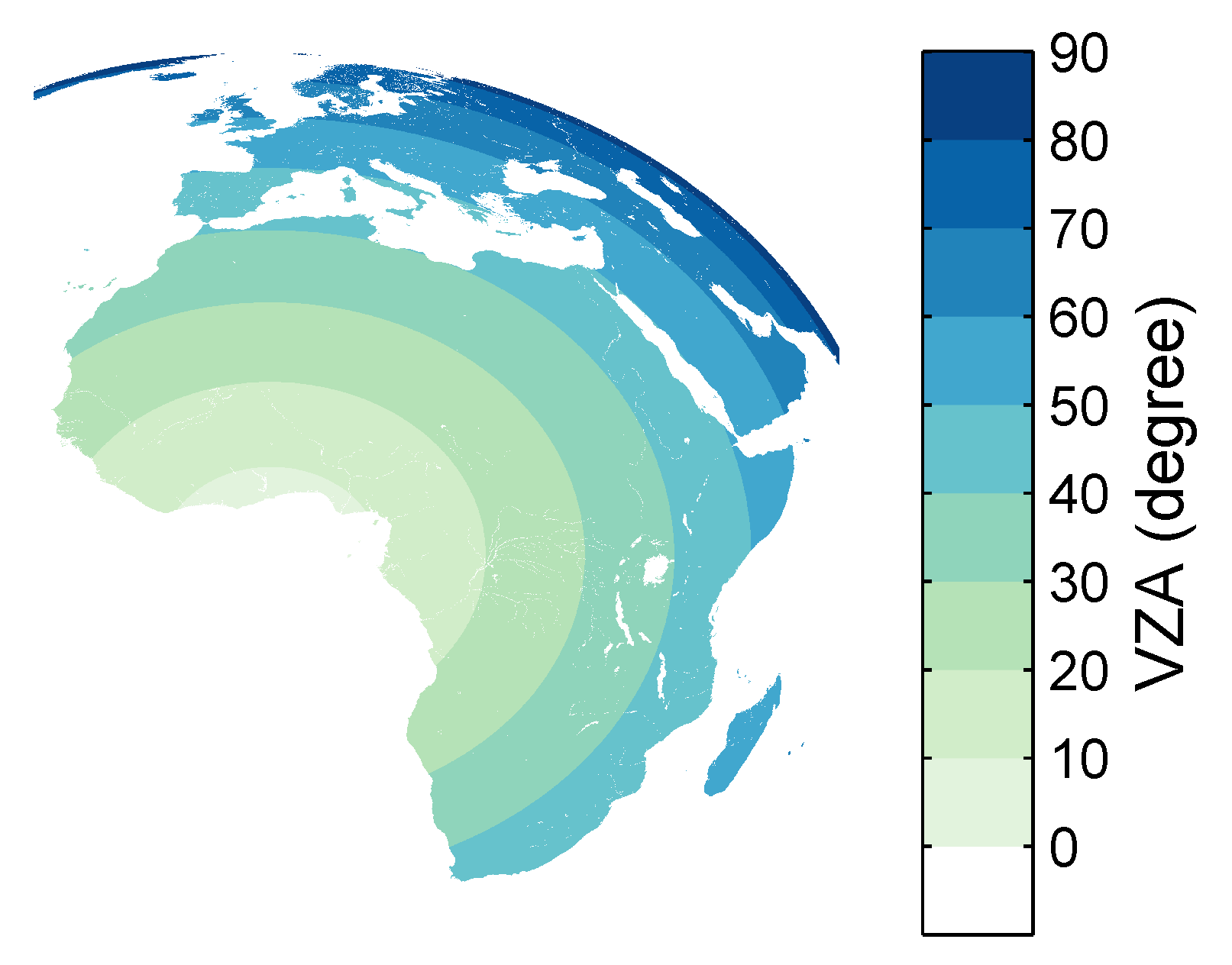
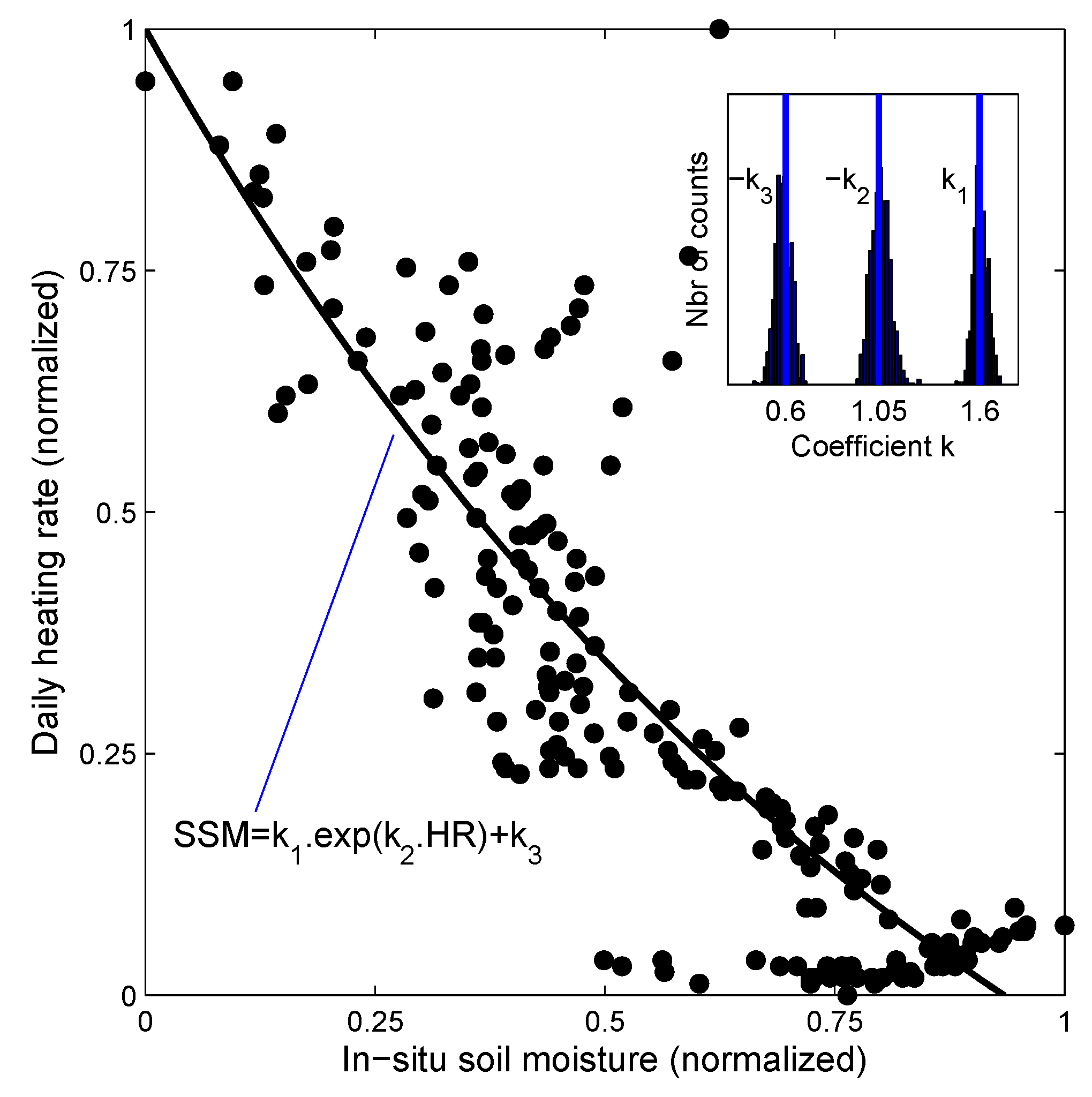
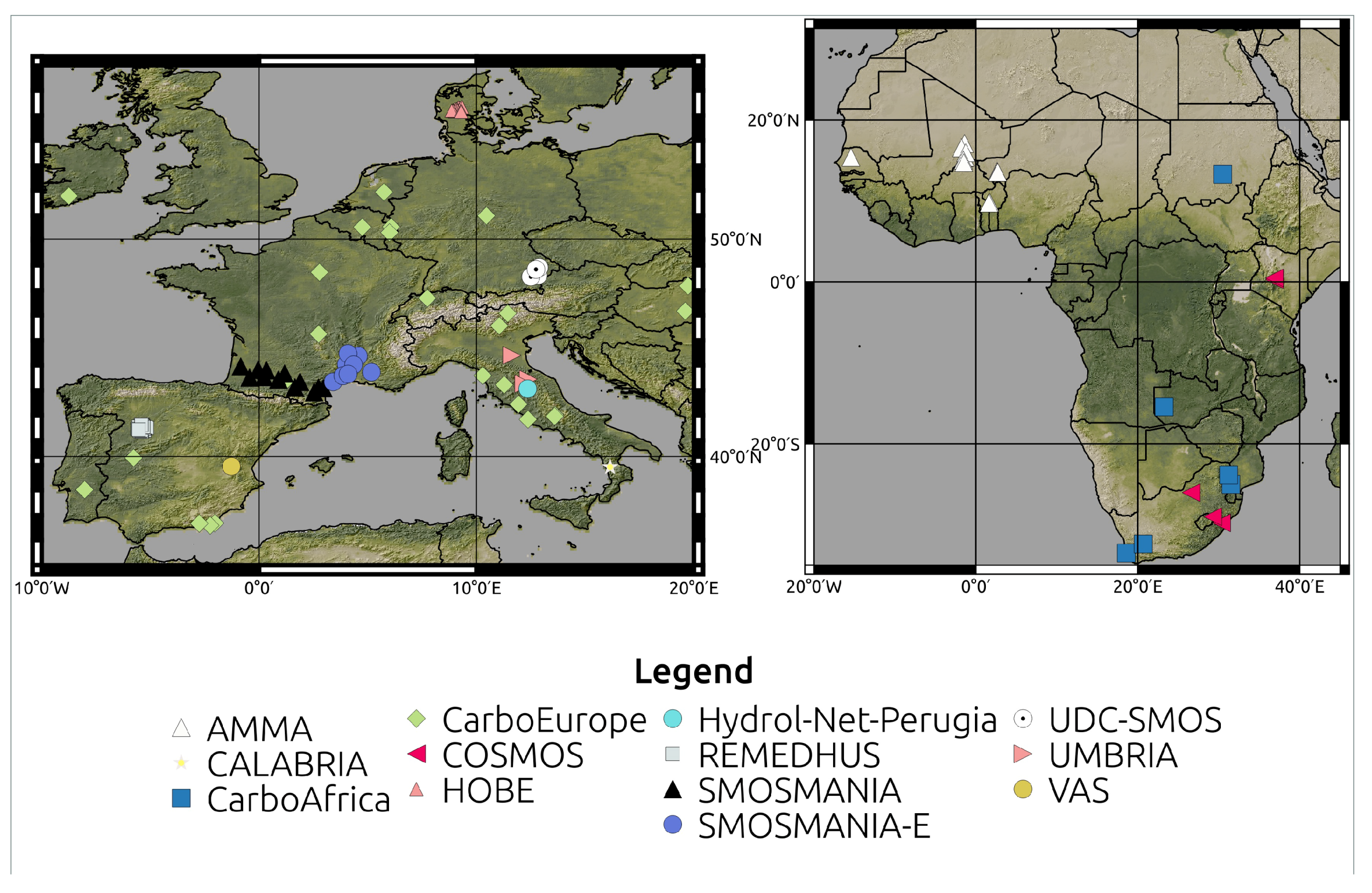
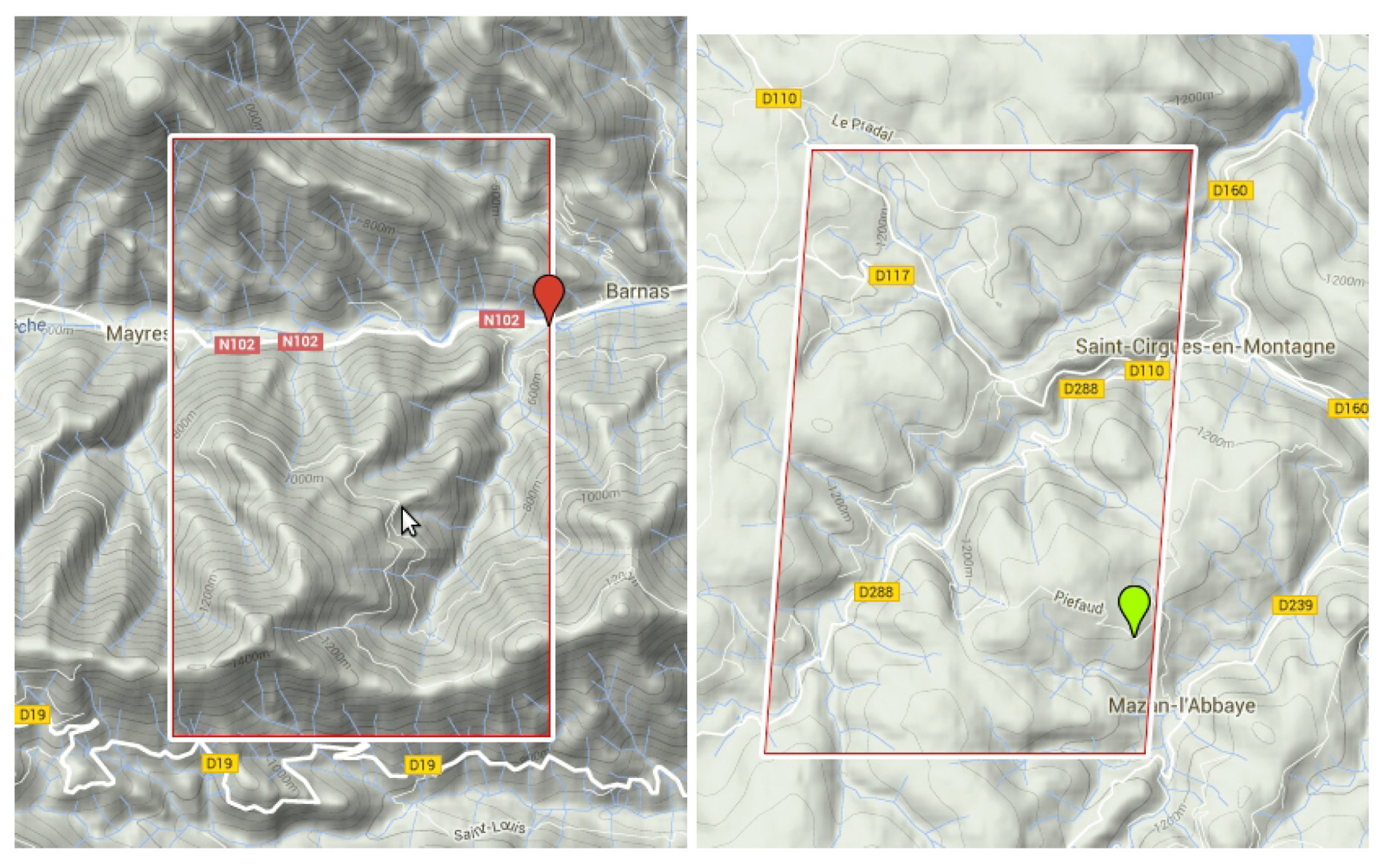
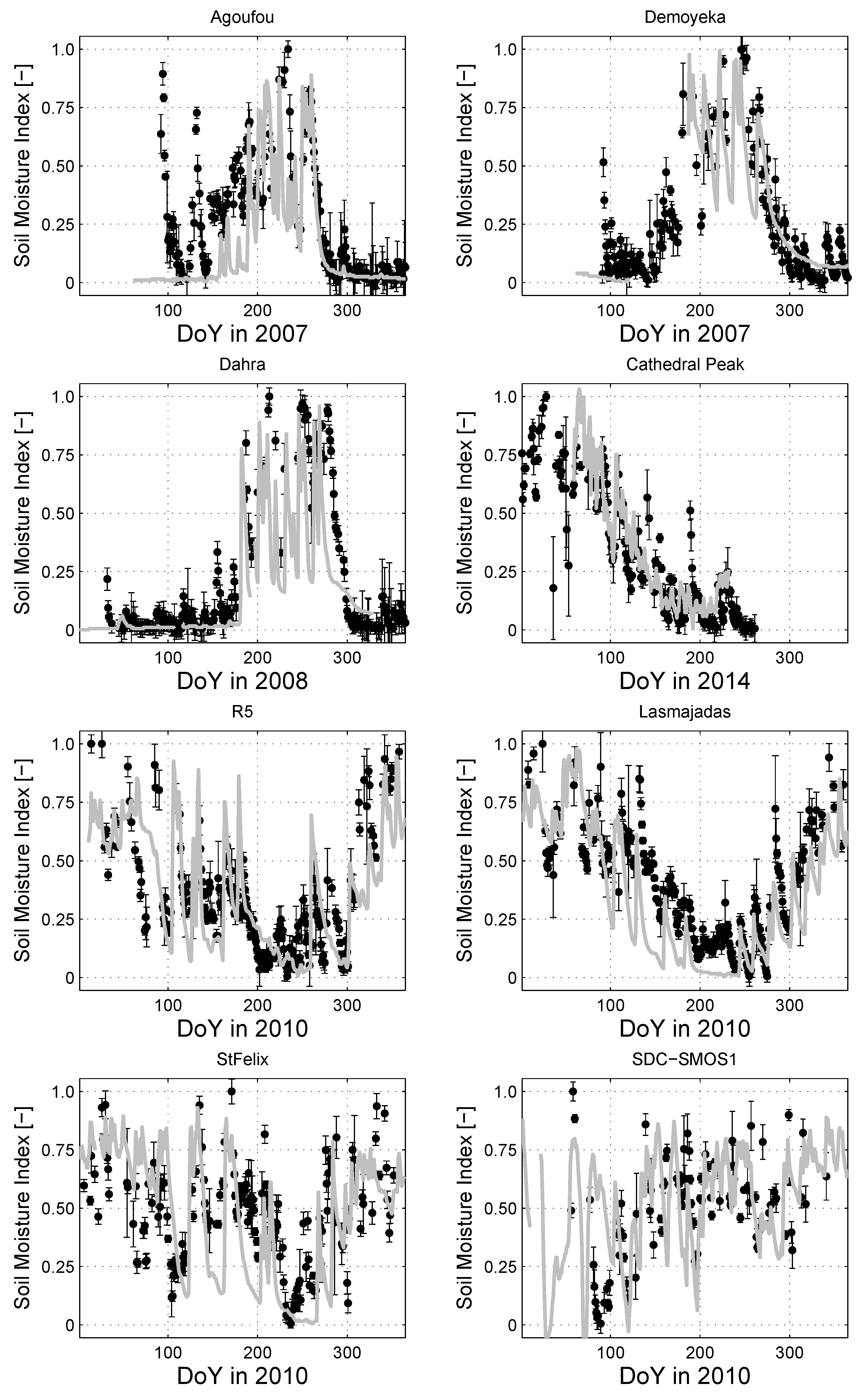
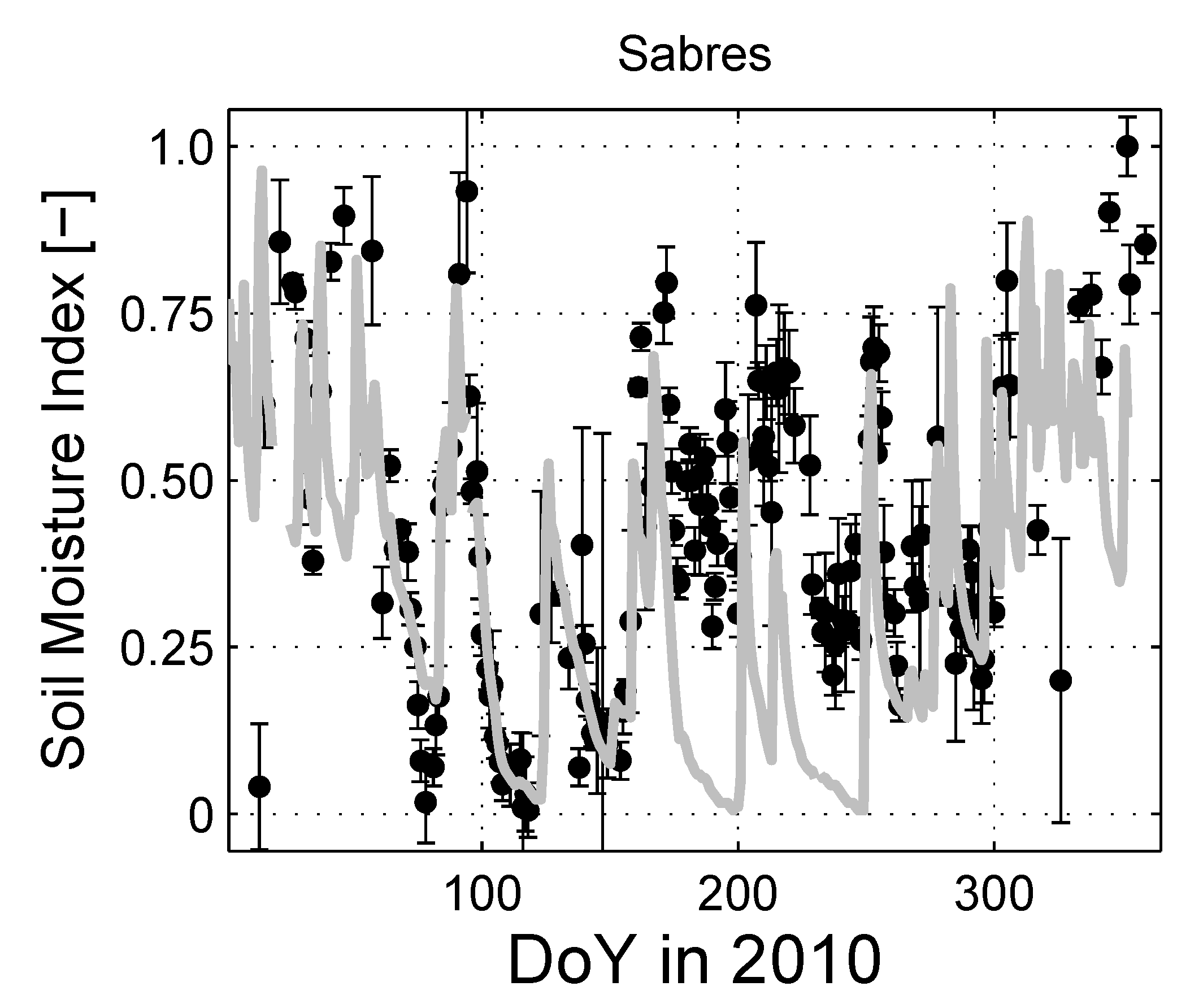

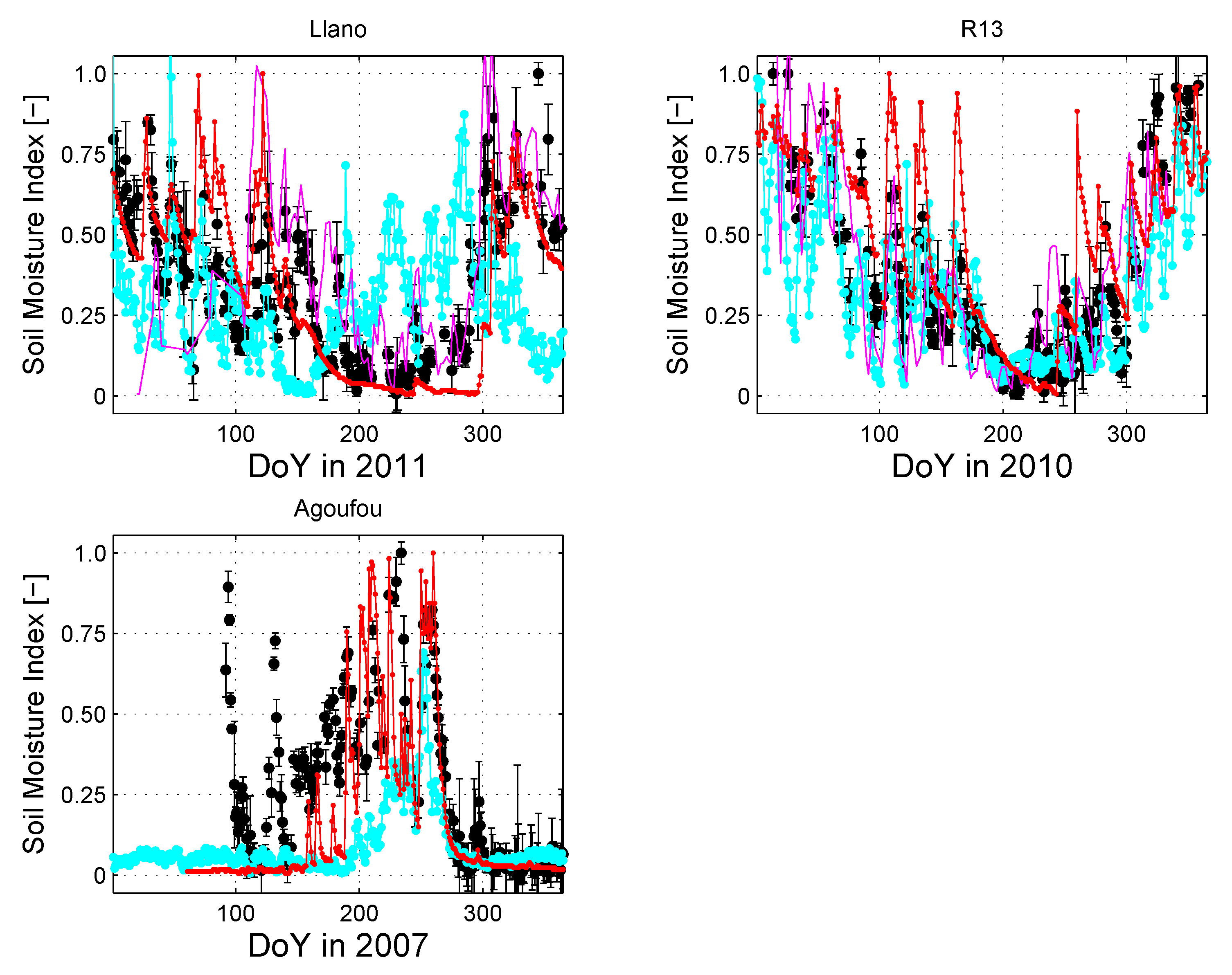
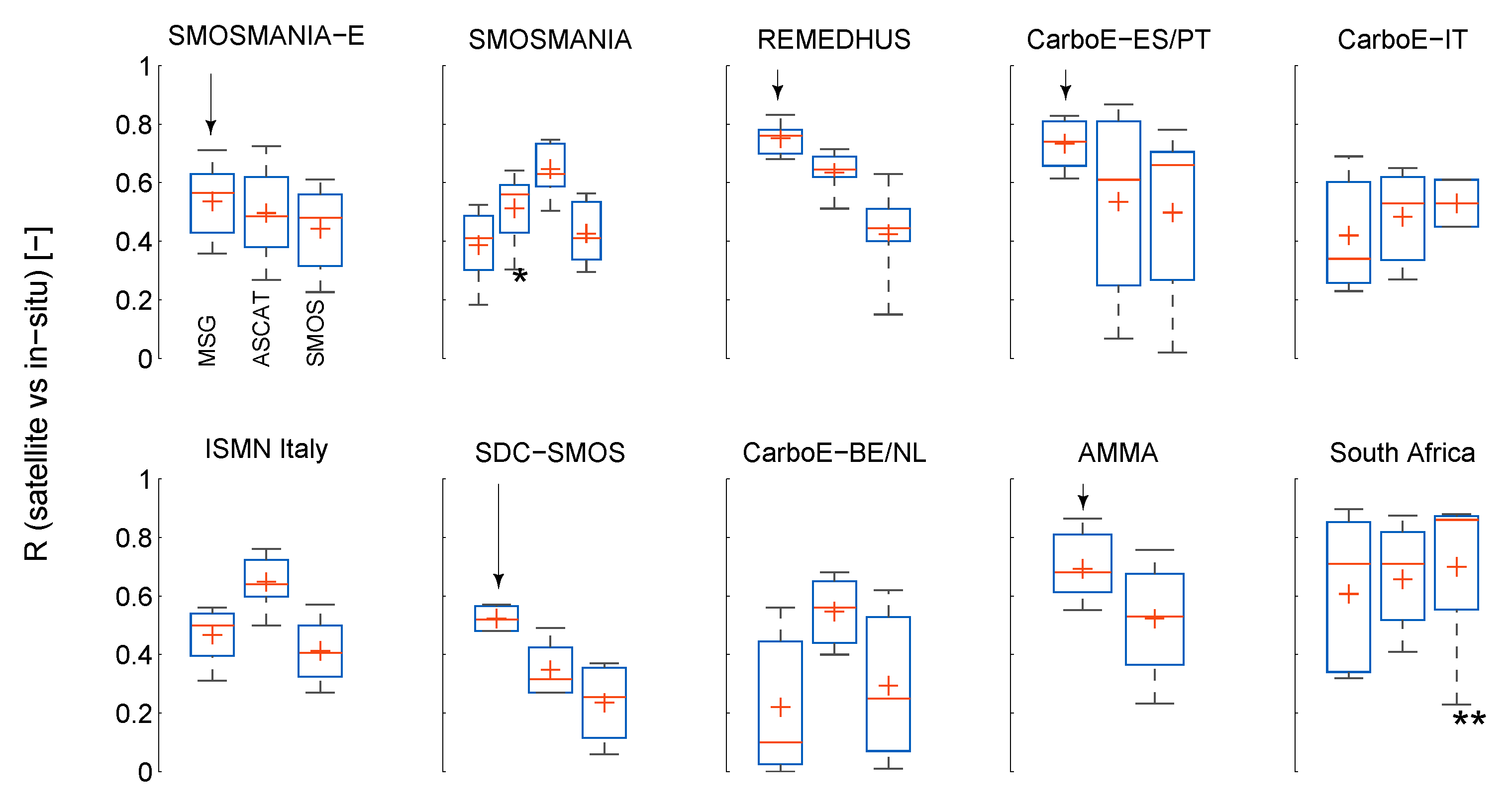

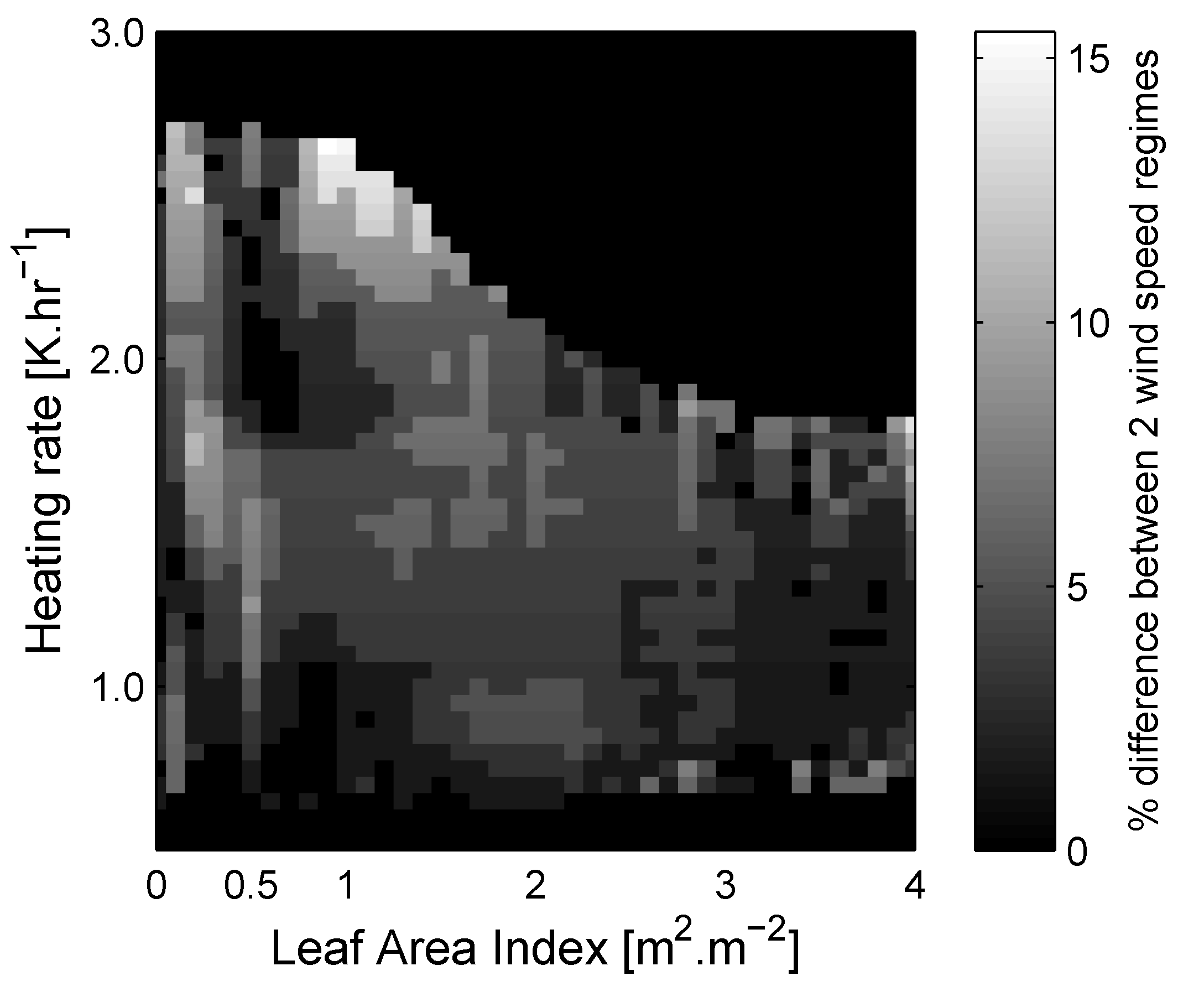
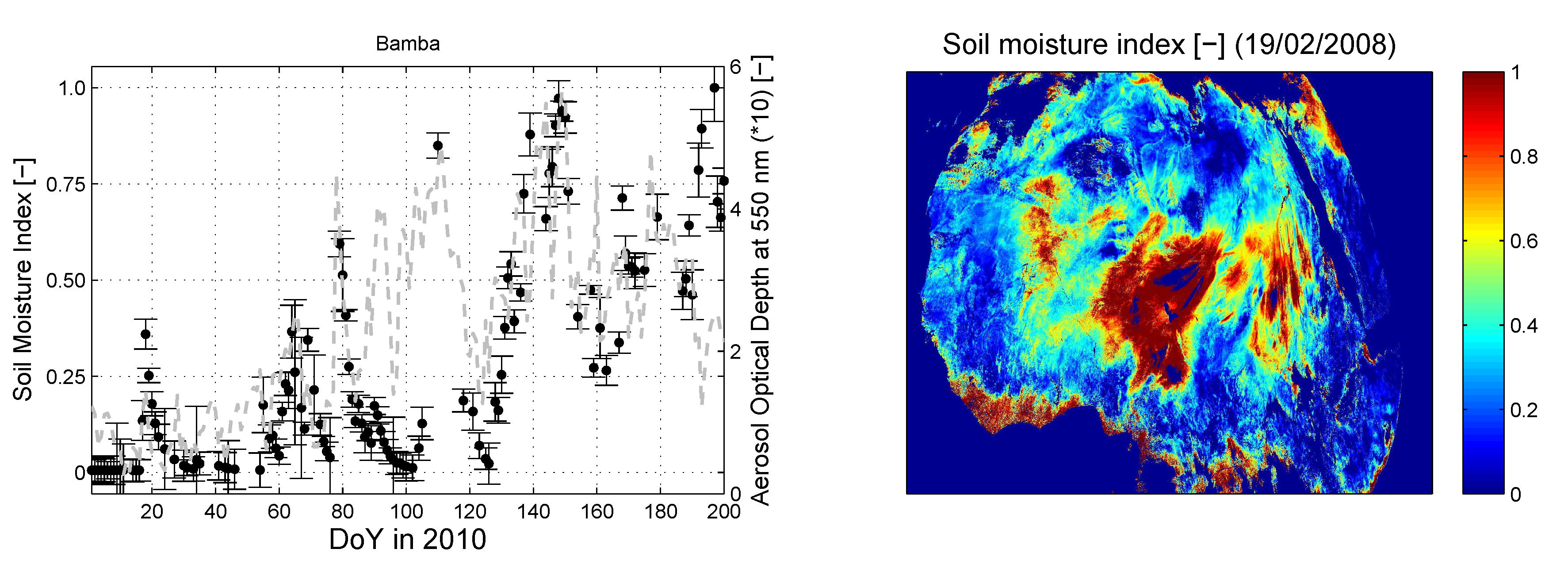
| Soil Moisture | Soil Layer | Number of | Years | Measurement |
|---|---|---|---|---|
| Dataset | Depth (cm) | Stations | Technique/Device | |
| AMMA (West Africa) | 5 | 13 | 2007–2012 | TDR CSC616 |
| REMEDHUS (Spain) | 5 | 21 | 2007, 2010 | TDR CSC616 |
| UMSUOL (Italy) | 10 | 1 | 2010 | TDR 100 |
| UDC-SMOS (Germany) | 5 | 4 | 2010 | IMKO TDR |
| CALABRIA (Italy) | 30 | 1 | 2010 | ThetaProbe ML2X |
| Hydrol-Net-Perugia (Italy) | 5 | 1 | 2010 | TDR-SM Eq Corp TRASE-BE |
| UMBRIA (Italy) | 5–15 | 3 | 2010 | ThetaProbe ML2X |
| VAS (Spain) | 0–5 | 1 | 2010 | Stevens Hydraprobe |
| HOBE (Denmark) | 0–5 | 18 | 2010 | Decagon 5TE |
| CarboItaly (Italy) | 2 | 5 | 2007, 2008, 2010, 2011 | TDR |
| CarboEurope (Spain & Portugal) | 0–5 | 5 | 2007, 2010, 2011 | ThetaProbe ML2X |
| CarboEurope (France) | 2 | 2 | 2007, 2010, 2011 | TDR |
| CarboEurope (Belgium, Netherlands) | 0–5 | 4 | 2007, 2010, 2011 | TDR |
| CarboEurope (Swiss, Germany, Hungary) | 0–5 | 4 | 2007, 2008, 2010 | TDR |
| SMOSMANIA (France) | 5 | 12 | 2007, 2010, 2011 | ThetaProbe ML2X |
| SMOSMANIA-E (France) | 5 | 9 | 2010, 2011 | ThetaProbe ML2X |
| CarboAfrica | 6 | 1 | 2007–2011, 2013 | TDR |
| COSMOS | - | 5 | 2007–2009, 2014 | CosmicRay Probes |
| Climate | Stations |
|---|---|
| Tropical Savannah(Aw) | AMMA (2), CarboAfrica(1), COSMOS (2) |
| Arid Steppe hot (Bsh) | AMMA (4), CarboAfrica (1) |
| Arid Steppe Cold (Bsk) | VAS (1), REMEDHUS (20), CarboEurope (1 ) |
| Arid Desert Hot (Bwh) | AMMA (7), CarboAfrica(1) |
| Arid Desert Cold (Bwk) | CarboEurope (2) |
| Temperate Dry Hot Summer (Csa) | SMOSMANIA(-E) (1, 1 ), Calabria (1 ), Hydrol-Net-Perugia (1 ), |
| CarboEurope (2, 4 ) | |
| Temperate Dry warm Summer (Csb) | SMOSMANIA(-E) (2,2 ), CarboAfrica (1) |
| Temperate without dry season, warm summer (Cfb) | Umbria (3 ), SMOSMANIA (1, 1), COSMOS (1) |
| Temperate without dry season, cold summer (Cfc) | CarboEurope (6), SMOSMANIA(-E) (1, 6 ) |
| Temperate dry winter hot summer (Cwa) | CarboAfrica (1), COSMOS (1) |
| Temperate dry winter warm summer (Cwb) | COSMOS (1) |
| Cold without dry season, cold summer (Dfc) | UDC-SMOS (4), |
| HOBE (18), | |
| SMOSMANIA(-E) (5 ) |
| Datasets | R | Bias | RMS | obs/yr (Mean) | st-yr |
|---|---|---|---|---|---|
| AMMA | 0.69 | 0.17 | 0.26 | 202 | 29 |
| CALABRIA | 0.19 | 0.02 | 0.21 | 48 | 1 |
| COSMOS | 0.88 | 0.09 | 0.16 | 154 | 5 |
| CarboAfrica | 0.54 | 0.10 | 0.25 | 170 | 7 |
| CarboEurope | |||||
| BE&DE&NL | 0.39 | −0.09 | 0.30 | 71 | 6 |
| FR&IT&CH | 0.45 | −0.01 | 0.29 | 150 | 9 |
| ES&PT | 0.75 | 0.10 | 0.21 | 221 | 10 |
| HU | 0.33 | −0.07 | 0.27 | 112 | 2 |
| HOBE | 0.24 | 0.06 | 0.29 | 77 | 18 |
| Hydrol-Perugia | 0.56 | −0.25 | 0.35 | 183 | 1 |
| REMEDHUS | 0.68 | 0.04 | 0.21 | 208 | 24 |
| SMOSMANIA | 0.39 | 0.08 | 0.29 | 139 | 26 |
| SMOSMANIA-E | 0.54 | 0.04 | 0.25 | 171 | 14 |
| UDC-SMOS | 0.48 | −0.16 | 0.21 | 103 | 4 |
| UMBRIA | 0.50 | −0.11 | 0.25 | 163 | 2 |
| Climate | |||||
| Aw | 0.81 | 0.12 | 0.21 | 171 | 8 |
| Bsh | 0.65 | 0.17 | 0.27 | 192 | 16 |
| Bsk | 0.64 | 0.03 | 0.22 | 202 | 26 |
| Bwh | 0.61 | 0.18 | 0.27 | 223 | 11 |
| Bwk | 0.69 | 0.12 | 0.23 | 244 | 2 |
| Csa | 0.58 | 0.07 | 0.25 | 182 | 17 |
| Csb | 0.53 | 0.12 | 0.26 | 159 | 8 |
| Cwa | 0.60 | 0.07 | 0.18 | 122 | 2 |
| Cwb | 0.88 | 0.14 | 0.17 | 126 | 1 |
| Cfb | 0.66 | 0.06 | 0.22 | 156 | 6 |
| Cfc | 0.44 | 0.01 | 0.27 | 139 | 22 |
| Dfc | 0.36 | 0.00 | 0.29 | 107 | 41 |
© 2019 by the authors. Licensee MDPI, Basel, Switzerland. This article is an open access article distributed under the terms and conditions of the Creative Commons Attribution (CC BY) license (http://creativecommons.org/licenses/by/4.0/).
Share and Cite
Ghilain, N.; Arboleda, A.; Batelaan, O.; Ardö, J.; Trigo, I.; Barrios, J.-M.; Gellens-Meulenberghs, F. A New Retrieval Algorithm for Soil Moisture Index from Thermal Infrared Sensor On-Board Geostationary Satellites over Europe and Africa and Its Validation. Remote Sens. 2019, 11, 1968. https://doi.org/10.3390/rs11171968
Ghilain N, Arboleda A, Batelaan O, Ardö J, Trigo I, Barrios J-M, Gellens-Meulenberghs F. A New Retrieval Algorithm for Soil Moisture Index from Thermal Infrared Sensor On-Board Geostationary Satellites over Europe and Africa and Its Validation. Remote Sensing. 2019; 11(17):1968. https://doi.org/10.3390/rs11171968
Chicago/Turabian StyleGhilain, Nicolas, Alirio Arboleda, Okke Batelaan, Jonas Ardö, Isabel Trigo, Jose-Miguel Barrios, and Francoise Gellens-Meulenberghs. 2019. "A New Retrieval Algorithm for Soil Moisture Index from Thermal Infrared Sensor On-Board Geostationary Satellites over Europe and Africa and Its Validation" Remote Sensing 11, no. 17: 1968. https://doi.org/10.3390/rs11171968






